|
| | How Marie Antoinette's BFF Lost her Head |  |
| | | Auteur | Message |
|---|
Little Po

Nombre de messages : 119
Date d'inscription : 15/04/2015
 |  Sujet: How Marie Antoinette's BFF Lost her Head Sujet: How Marie Antoinette's BFF Lost her Head  Dim 27 Déc - 17:02 Dim 27 Déc - 17:02 | |
| Let me share this with you, dear Forum, about Princesse Lamballe, Marie-Antoinette's best friend. 
- How Marie Antoinette's BFF Lost her Head
- "THE QUEEN WANTS ME; I MUST LIVE AND DIE NEAR HER."
We’ve all heard of Queen Marie Antoinette, and her unlucky fate at the blade of the revolutionary guillotine. But not many know the tragic tale of her best friend, Marie Thérèse Louise of Savoy, Princesse de Lamballe. Lamballe was killed a month before her beloved queen, humiliated and beaten to death in a crowded street by enraged revolutionaries. This is her melodramatic story: Marie Thérèse was was born to a German princess and a Sardinian prince on Sept. 8, 1749. She was, quite simply, a bourgeois bitch: a descendant of the prestigious House of Savoy. She would have been your typical dispensable aristocrat, had her family not arranged a prodigious marriage on her part. A Lovely Wedding Louis Alexandre de Bourbon Louis Alexandre de BourbonThanks to internal connections, Lamballe was swiftly married off to Louis Alexandre, Prince of Lamballe – great grandson of Louis XIV a.k.a. The Sun King, and consummate French royalty. The prince was also a spoiled brat and a notorious womanizer. He was red-haired, with a tall, strong build and luminous eyes. The prince was said to be attractive to women, who he pursued readily. He was even rumored to have been friends with the perverted libertine Marquis de Sade. This arranged marriage was his father’s bid to subdue the wily prince: he felt the shy and reserved Lamballe would chastise his perverse son. Most importantly: she was nonthreatening and not the sharpest pencil in the box. Madame du Barry, infamous mistress of Louis XV, called Marie Thérèse “destitute of wit.” 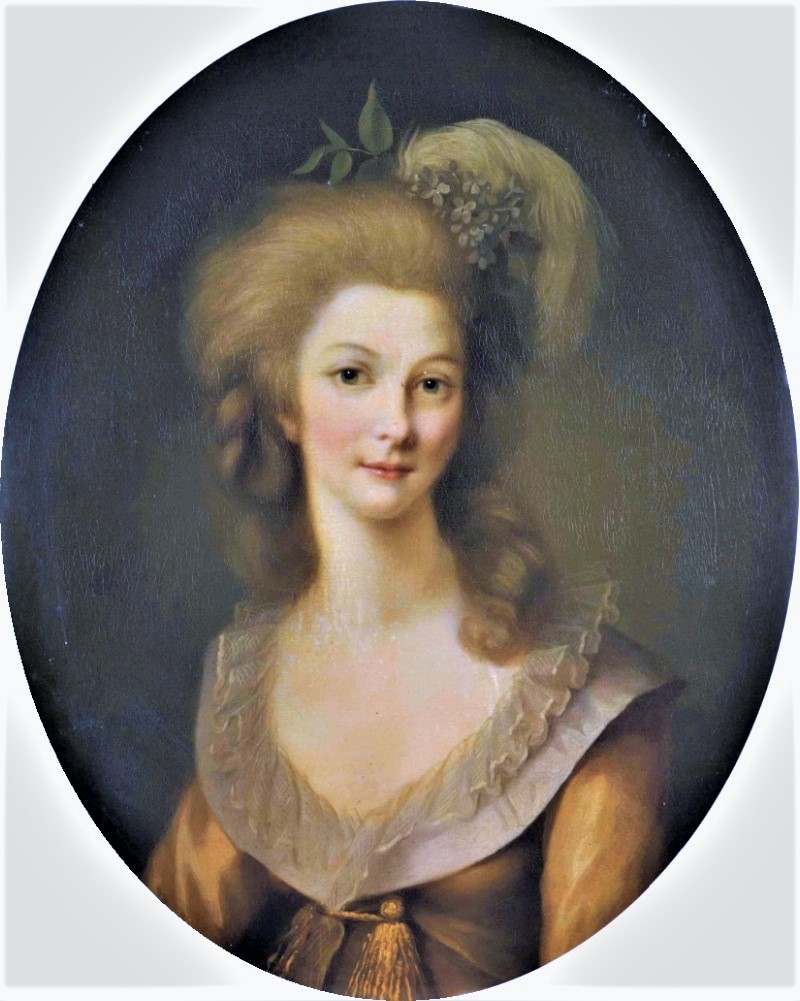 The Princess in 1779, by Marie Victoire Lemoine The Princess in 1779, by Marie Victoire LemoineMarie Thérèse was not conventionally attractive: she had a big nose, a giraffe neck, and sloped shoulders; plain in both mannerisms and appearance. There were some positives about her, like her smooth skin that was described as “delicately fair,” as well as clear blue eyes and long golden hair that was compared to Raphael’s madonnas. Overall, she was considered a righteous, moral, kind woman with a good temperament. In January of 1767, the couple was married off in a luxurious 10 day ceremony with celebrations and feasts taking place in both France and Italy. She was now officially a princess! She was only 17 years old and the prince was 19. The pair were both Virgos with close birthdays: two hard-headed individuals meant to clash. Before the wedding, the prince went to go see his future bride to bring her a bouquet of flowers, disguising himself as his own servant. Upon discovering his gag, Lamballe was charmed and intrigued. She said of it: “I hope[d] my prince will allow his page to attend me, for I like him much. What was my surprise when the Duc de Penthièvre presented me to the Prince and I found in him the page for whom I had already felt such an interest! We both laughed and wanted words to express our mutual sentiments. This was really love at first sight.” The couple spent their honeymoon at the Château de Nangis, a pleasant mini castle where Joan of Arc had once walked.  The lovely Château de Nangis. The lovely Château de Nangis.At first, the couple was said to be enamored by one another as there was a strong physical attraction between them. The princess must have been getting some good dick, as she wrote to her mother “it is very pleasant to find thus in my duties my sweetest enjoyments.” Soon enough, however, the prince fell back into his degenerate, polygamous ways. Sins and PunishmentsAfter a few months of marital bliss, the prince began affairs with numerous women, even impregnating an opera singer at one point. The prince also used his wife’s diamonds to pay off his debts, as well as cruelly re-gifting them to his mistresses.  Portrait of the princess by Pierre Claude François Delorme (1783-1859) Portrait of the princess by Pierre Claude François Delorme (1783-1859) Princess de Lamballe was humiliated by her husband’s errant behaviour and infidelity. She found consolation in her social life at the royal court at the Palace of Versailles. The princess also became close with her husband’s father, Louis Jean Marie de Bourbon, Duke of Penthièvre. The duke was one of the richest and most powerful men in France, and he was very fond of his daughter-in-law. In May of 1767, the princess sent a lamentful letter to her mother: “Why is it that monsieur de Lamballe… warms my heart but all the fires of the love he has for me have suddenly changed? In vain I seek in my conduct that which might have caused this change, but I cannot find any cause… Can it be because I’m not with child? Is that a crime? His indifference kills me. But one thing that distresses me… is that I cannot doubt that the life he leads alters his health. A thousand forebodings overwhelm me. Oh my mother! Sympathize with my sorrows, and I will feel less bitter.” Due to her husband’s neglect, she began to faint and have nervous fits. Doctors diagnosed the princess with hysteria and so-called “convulsive vapors” and melancholia, when she was really just an upset teenager who was dismayed at being cheated on. Soon enough, the partying prince’s health began to deteriorate as well, but for different reasons. Louis Alexandre grew pale, tired, and ill, and was plagued with skin ulcers. He also badly injured himself by falling off a horse, so he went home and had his cuckolded wife and sister care for him. Karma was hitting him hard: the prince started wasting away, and was constantly feverish, exhausted and suffering from skin rashes. He had syphilis! Louis Alexandre had contracted venereal disease from one of the orgies he had attended. Doctors prescribed seven pounds of mercury to treat the syphilis, but it was to no avail. It completely was over for the pernicious prince. Louis Alexandre confessed his sins to a priest, and died on May 6, 1768, in the arms of his loyal wife. He was only 20, and their marriage had lasted a little over a year. 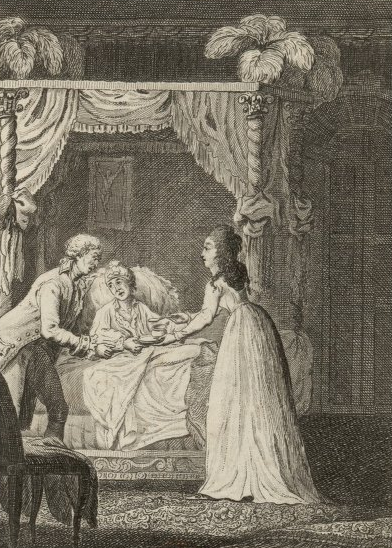 The death of the Prince of Lamballe, 1768. The death of the Prince of Lamballe, 1768.Now a widow at only 18, the princess briefly considered joining a convent. But really, why would she? It would be such a waste, and so boring. Marie Thérèse had just inherited a large fortune from her dead husband, and was ready for a new life. The Duc de Penthièvre took the young widow under his wing, and brought her to live with him in his gorgeous Château de Rambouillet. The château was far removed from the hustle and filth of Paris; a lush green country castle where the super-rich spent their days in utmost leisure. The princess enjoyed her relaxing days at this fair château, taking long walks in beautiful country forests and sitting by the window-side writing letters and self-reflecting. The princess and her father-in-law also spent time engaging in charitable projects to appease the jealous proles, and were called the “King of the Poor” and “The Angel of Penthiévre” respectively.  Château de Rambouillet, in northern France Château de Rambouillet, in northern FranceAnd so began Princess de Lamballe’s grand courtly life: she was so well reputed that she was even considered for a time as a possible wife for King Louis XV. However, nothing materialized of it, as he was already too enamored by his slutty mistress Madame du Barry. I'm terribly sorry, this is too long for a post. So this story is to be continued. 
_________________
Avec elle je ne suis plus la reine, je suis moi
|
|   | | Little Po

Nombre de messages : 119
Date d'inscription : 15/04/2015
 |  Sujet: Re: How Marie Antoinette's BFF Lost her Head Sujet: Re: How Marie Antoinette's BFF Lost her Head  Dim 27 Déc - 17:27 Dim 27 Déc - 17:27 | |
| If you don't mind, I go on.  - A Beautiful Friendship
The princess was introduced to dauphine Marie Antoinette in 1770, at her wedding bash to future King Louis XVI. Despite being six years older than her, the princess became fast friends with the dauphine.
Marie Antoinette described her as “the only woman I know who never bears a grudge; neither hatred nor jealousy is to be found in her.”
The outgoing, fashionable, pretty, strawberry-blonde haired Marie Antoinette was, personality wise, quite the opposite of de Lamballe. But they enjoyed the stability and consistency of one another’s affections.
Marie Antoinette helped the princess grieve and heal from the recent death of her sleazy husband, for which she would be grateful for until the end. The princess said:
“It was amid this gloom of human agony, these heart-rending scenes of real mourning, that the brilliant star shone to disperse the clouds, which hovered over our drooping heads…
It was in this crisis that Marie Antoinette came, like a messenger sent down from Heaven, graciously to offer the balm of comfort in the sweetest language of human compassion…
From that moment I became seriously attached to the Queen of France.”

Illustration by Michael Leonard for The Queen’s Confession, 1968.
In return, the princess gave her the utmost loyalty. Within the court of Versailles, Maire Antoinette was surrounded by bitchy haters who constantly criticized her for being unconventional and imprudent.
Many courtiers were incensed by her foreign heritage, and she earned the pejorative L’Autrichienne (the Austrian bitch).
Within this sea of bitterness, is it any wonder she needed a friend?
Marie Antoinette and the princess bonded by going on wintertime sleigh rides together, resplendent in fine ermine and sable furs. They were pulled through snowy Paris by horses that were decked in jingling bells and lux white head-plumes.
On May 10, 1774, King Louis XV died of smallpox. His grandson, the awkward and portly Louis XVI, succeeded him. Marie Antoinette went from despised dauphine to Queen of France in the abrupt blink of an eye.
Princess de Lamballe was now in a place of immense power and influence.
When the princess was away from the court for two months, Marie Antoinette missed her dearly, and had Lamballe’s portrait painted in her looking-glass room. The two even started wearing matching coordinated outfits. They were, like, total BFFs forever.
The Queen was said to have remarked to Louis XVI that “the Princesse de Lamballe’s friendship is the charm of my life.”
In September of 1775, Marie Antoinette attracted controversy when she appointed Lamballe the title of “Superintendent of the Queen’s Household.”

Marie Antoinette with the rose, 1783, by Élisabeth Vigée-Lebrun
This post was so contentious that it had been left vacant for 30 years, as it was a very highly-paid and influential position. And now, with this honor bestowed upon her, Princess de Lamballe was the highest-ranking Lady in Waiting in all the court.
Many were unhappy with this appointment, as they felt de Lamballe was too much of a fragile drama queen to handle such responsibility. She was once said to have fainted of shock when a lady-in-waiting unexpectedly and noisily yawned near her.
The princess’ brother Eugène was also promoted to regiment commander in the French military, thanks to his sister’s connections.
Marie Antoinette’s mother Empress Maria Theresa grew concerned with the amount of influence the Princess de Lamballe was accumulating.
Comte de Mercy-Argenteau, an Austrian diplomat that Marie Antoinette’s mother used to keep an eye on her, reported to the Empress that:
“This lady joins to much sweetness a very sincere character, far from intrigue and all such worries… the choice is excellent…
All the same, I have taken the precaution to point out to the Queen that her favour and goodness to the Princesse de Lamballe are somewhat excessive, in order to prevent abuse of them from that quarter.”
Rivalry
In the spring of 1775, starving French peasants rioted due to extensive grain shortages. This was nicknamed the Flour War. Louis XVI was not doing a good job feeding his people. Consequences were to come…
But not yet. Marie Antoinette was still enjoying her sexy, exciting royal life. And she had made a new friend: Yolande Martine Gabrielle de Polastron, Duchess of Polignac.

The Duchess de Polignac by Elisabeth Vigée-Lebrun, 1782
The pretty, violet-eyed, charismatic duchess caught the Queen’s eye immediately. The duchess was more attractive and smooth than the neurotic and humble Lamballe, but she was also more gossipy.
Marie Antoinette was turned on by the duchess’ cavalier devil-may-care attitude. The Queen paid off the duchess and her husband’s 400k franc gambling debts so they could permanently move into Versailles.
There was also a strange coincidence: Princess de Lamballe and the Duchesse de Polignac were born on the exact same day, of the exact same year! This bode well for a blooming friendship, right?
Wrong.
The two hated one another, and vied for Marie Antoinette’s affections. The Queen began to prefer the duchess’ company over the princess. She was, after all, way cooler than the dorky, fainting Princess de Lamballe.
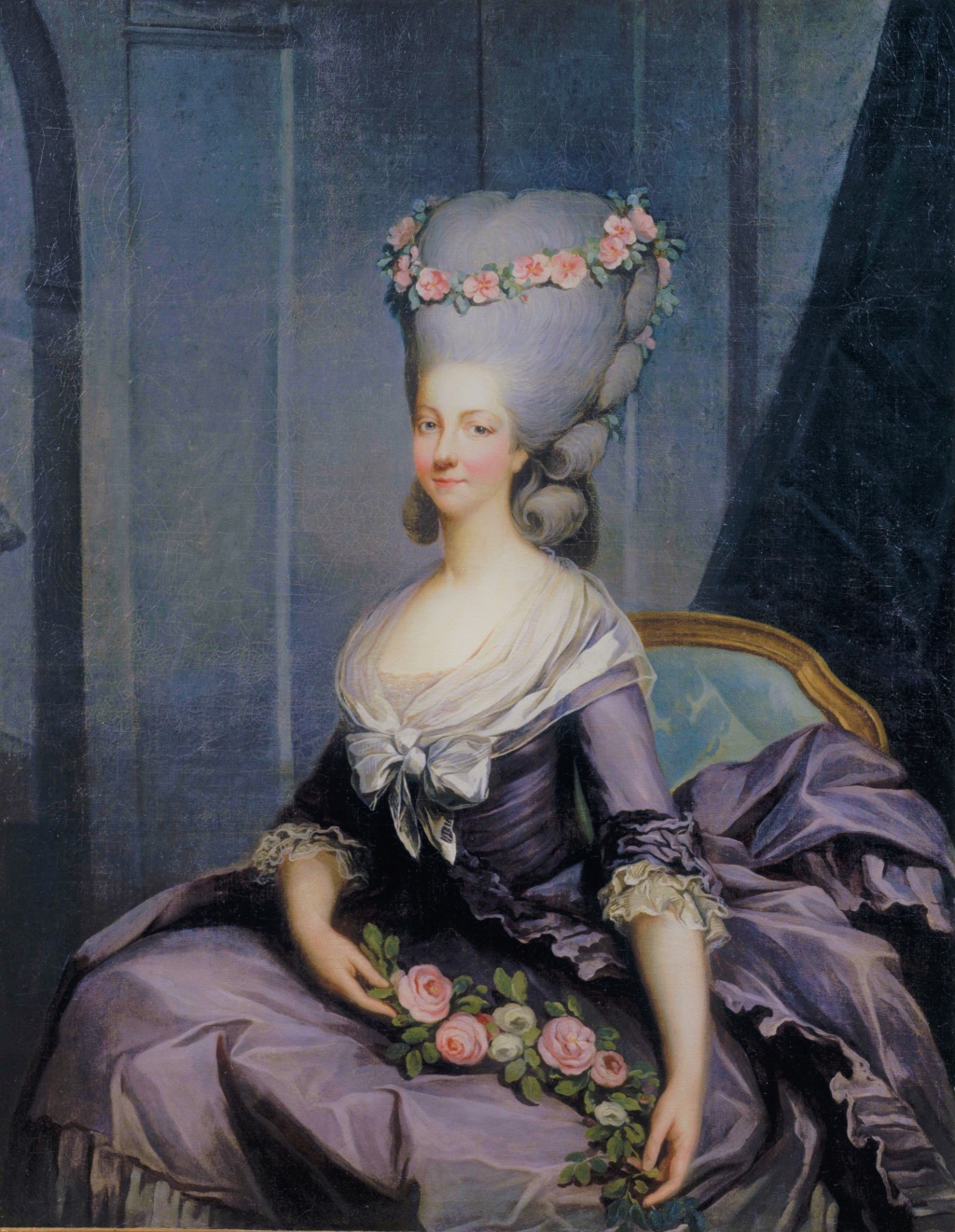
La princesse de Lamballe by Antoine-François Callet, circa 1776.
At this time, the Queen’s advisers complained de Lamballe was getting paid way too much for her Superintendent position. She was already rich via her father-in-law, and owned many empty homes that she did not even live in.
Lamballe refused to relinquish any privileges or her 50k crown salary, and rumors spread that she was a greedy bitch.
Princess de Lamballe began to get an inkling that the tides were turning against the monarchy.
Many peasants and courtiers alike began to make apparent their disdain for Marie Antoinette’s expensive and bimboish obsession with fashion and fancy living, which was seen as especially distasteful during periods of terrible famine and starvation for the lower class.
The Queen laughed off the princess’ advices against being too decadent, and joked with the Duchess de Polignac at what a bore the princess was.

Detail of Louis XVI, Marie Antoinette, and their son in a 1782 portrait of The French Royal Family.
Comte Mercy-Argenteau witnessed their constant disagreements, noting:
“Constant quarrels, in which the Princesse seemed always to be in the wrong…
The Princesse de Lamballe loses much in favour. I believe she will always be well treated by the Queen, but she no longer possesses her entire confidence…
The Princesse is very little seen at court. The Queen, it is true, visited her on her father’s death, but it is the first mark of kindness she has received for long.”
The cunty duchess also did her best to create a wedge in the princess and the Queen’s friendship.
When the Queen retreated to the colossal 1,500-room Château de Fontainebleau in autumn of 1776, she chose to bring the princess with her, instead of the duchess.
At the end of 1776, de Lamballe was plagued by a bad attack of measles. The Queen sent her heartfelt, touching, worried letters inquiring about her health.
In 1778, when the princess’ mother died, the Queen and King both wrote sweet letters of consolation.
Marie Antoinette signed off with “I embrace you again with my whole heart, as I shall love you all my life.”
Louis XVI added “You know how much we love you. May God be with you.”
Despite the fact that both her parents had died that year, the princess was there for moral support when the Queen gave birth to her first child: Marie-Thérèse Charlotte, or Madame Royale.
It was a horrible 12-hour labour, in which Marie Antoinette almost died of suffocation. The delicate de Lamballe of course fainted after witnessing this.
Extravagance and Depravity
There were rumours spreading around Paris that Marie Antoinette was cheating on her husband, as well as having lesbian relationships with the Princess de Lamballe and the Duchess de Polignac.
One must note that Princess de Lamballe was not known to have taken any lovers after her husband died. She appeared to have a limited interest in love affairs and men. Could it be that she was into women? It is impossible to prove or disprove.
Marie Antoinette, on the other hand, really knew how to trigger people. She was a gambling addict, took the company of men who were not her husband, and loved the theatrical arts.
The Queen, herself, acted in plays, and was said to have been a terrible performer. The Duchess de Polignac ensured that the Princess de Lamballe was barred from attending any performances.

Interior of the magnificent Hôtel de Toulouse, home of Princess de Lamballe.
In 1790, when Marie Antoinette’s mother died, she withdrew to mourn with the princess and the duchess in private. Subsequently, the Queen increased de Lamballe’s salary to match her loyalty.
The princess was having a fun time giving tea parties and riding hot air balloons at the wonderful Hôtel de Toulouse, which was owned by her father-in-law, the Duke of Penthièvre. Her bedroom was an opulent salon gilded in gold and velvet.
In December of 1784, a bandit named Pierre Poulailler tried to burn down the Hôtel. The princess awoke the duke at 1 AM, and they escaped the inferno. Police extinguished the fire promptly.
As for Pierre, he was said to have killed 150 people in his life of crime. He once even sealed a man alive inside a building. When Pierre was captured, his bones were broken on a torture wheel and then he was burned alive.
Wasn’t 18th century France just lovely?
Downfall
Following the infamous 1785 Affair of the Diamond Necklace, Marie Antoinette’s already questionable reputation was irreparably tarnished. The peasants nicknamed her “Madame Deficit,” blaming the Queen for the country’s dire financial plight.
In 1787, the princess was in poor health and France was on the brink of bankruptcy. Political troubles were brewing steadily.
The princess set off to England for a health retreat. She viewed Herschel’s Forty-Foot Telescope, and had dinner with writer Horace Walpole.
Like the condescending gout-ridden Englishman he was, Walpole remarked “I have no particular penchant for sterling princes and princesses, much less for those of French plate.”
By 1788, most of Louis XVI’s parliament and a veritable array of aristocrats had turned against him for attempting to tax them. They simply refused to pay up, even though there was a poor harvest that year and French citizens were facing starvation.
This was the period when the Jacobins banded together, and republican Maximilien de Robespierre started his rise to glory and power.
The conflict between the King and his unruly subjects finally climaxed with the Storming of the Bastille prison in 1789.
The prison was supposed to symbolize all of the King’s tyrannies and evil. But when the approximately 1,000 partisans of the Third Estate broke in, there were only seven prisoners within!
99 citizens died during the action.
Il must admit I deleted a little part of the story, ea the one concerning the storming of the Bastille. I also removed some inaccurate pictures. It's not finished yet. 
_________________
Avec elle je ne suis plus la reine, je suis moi
|
|   | | Colibri

Nombre de messages : 183
Date d'inscription : 03/12/2017
 |  Sujet: Re: How Marie Antoinette's BFF Lost her Head Sujet: Re: How Marie Antoinette's BFF Lost her Head  Dim 27 Déc - 17:29 Dim 27 Déc - 17:29 | |
| Je vais pas tout comprendre c'est en anglais.  Mais les photos sont jolies. 
_________________
cui cui cui
|
|   | | aspi

Nombre de messages : 70
Date d'inscription : 29/09/2019
 |  Sujet: Re: How Marie Antoinette's BFF Lost her Head Sujet: Re: How Marie Antoinette's BFF Lost her Head  Dim 27 Déc - 17:41 Dim 27 Déc - 17:41 | |
| Je salue l'idée. On ne parle pas assez de la bonne princesse de Lamballe, dans ce forum.
_________________
Backwards and forwards in a circle they went.
|
|   | | Little Po

Nombre de messages : 119
Date d'inscription : 15/04/2015
 |  Sujet: Re: How Marie Antoinette's BFF Lost her Head Sujet: Re: How Marie Antoinette's BFF Lost her Head  Dim 27 Déc - 17:45 Dim 27 Déc - 17:45 | |
| So let's go on.  - The Unraveling of the Monarchy
Unable to control the angry mobs of rioters any longer, the King advised his supporters to flee the country for their own safety, as he could no longer protect them.
While this was all going down, Princess de Lamballe was in Switzerland on a leisure trip.
When the third estate demanded that the nobles cough up some of their baubles to help pay France’s national debt, the princess was very hesitant to contribute.
Marie Antoinette was the same: she unwisely chose to wear her most beautiful and expensive jewelry while attending a delegation in August.

Louis XVI and Marie Antoinette in the Gardens of Versailles with their Children, by Charles Louis Lucien Muller, 1857.
Three months later, another monumental event occurred: The Women’s March on Versailles.
On October. 5, following a large feast at the king’s palace; a mob of almost 10,000 starving, enraged women and revolutionary agitators set off from the Parisian marketplace to Versailles, armed with weapons.
Why were the starving peasants forced to pay taxes, while the comfy aristocrats were exempt? It was time for an answer.
When they arrived, the mob demanded the king provide grain for their hungry families. Louis XVI relented and promised to take care of the issue, then he and his family settled in to sleep for the night.

The Queen’s bedchamber at Versailles.
But the suspicious mob broke into the palace and attacked and murdered the guards. Again, they decapitated their victims and placed the guards’ heads onto pikes.
Marie Anoinette nearly escaped being bayoneted to death in her bedchambers by angry rioters.
By now, the mob had reached 60,000, and they forced the King and Queen to leave Versailles and return to Paris: to live in the dilapidated Tuileries Palace. Louis XVI was now at the mercy of his people.
Two days after this chaotic event, the ever-loyal princess went to Tuileries to provide emotional support to her Queen. Upon her arrival, Marie Antoinette collapsed into the princess’ arms and began sobbing.

Marie Antoinette faces the mob on her Versailles balcony. By Michael Leonard for The Queen’s Confession, 1968.
The princess resumed her superintendent position, and moved into the Pavillon de Flore to stay close to the Royal family. She referred to her apartment there as a “dungeon” compared to what she had had in Versailles.
Since the King and Queen were virtual prisoners at this point, they decided to try and escape Paris to go to the royalist stronghold of Montmédy; which bordered Marie Antoinette’s beloved Austria.
The Queen gave the princess a very affectionate farewell before her escape. The princess found out next morning, and set off to meet them in Montmédy.
The attempt failed disastrously, and the King and Queen were captured in Varennes on June 21, 1791, and forced to return back to Paris.
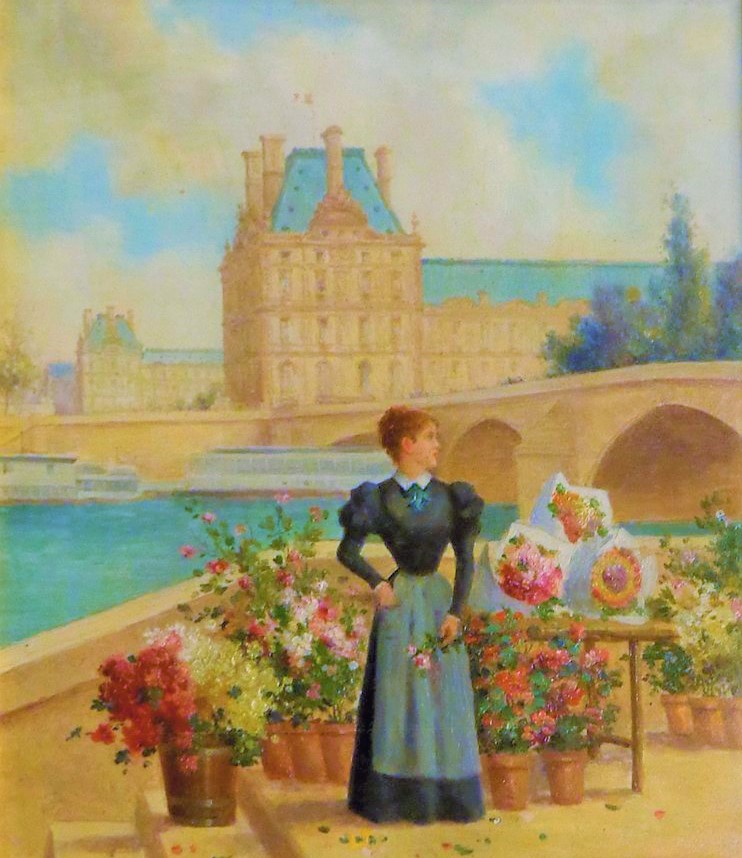
The Florist and the Pavillon de Flore (ca. 1900), by the painter Émile Baré.
Lamballe was steadfast, and after waiting in Montmédy for a week, she sent Marie Antoinette this lamentful letter:
“I … wait [for] your Majesty’s command… When your Majesty wears fetters, can liberty be of any value to me? When your Majesty is bathed in tears, can any tranquility enter in to the bossom.”
The princess desperately wanted to help her Queen, but was advised to stay afar in Brussels. Marie Antoinette did not want the princess to return as she feared for her dear friend’s life.
The Queen wrote to Lamballe:
“Your friendship is my consolation and my only happiness… Do not return, do not throw yourself in the tiger’s jaws; the present is too terrible.”

Princess de Lamballe by Anton Hickel, 1788.
Marie Antoinette sent the princess a gold ring which was looped with strands of her own her that had been “turned white by misfortune.” Oh the drama.
Even the Duc de Penthièvre tried to halt his daughter-in-law’s return; entreating Lamballe’s cousin, the King of Sardinia, to try and convince her to go hide it out with the Savoy family.
She wrote him an epic letter declining all help:
“I do not recollect that any of our illustrious ancestors of the house of Savoy… ever dishonored or tarnished their illustrious names with cowardice.
I cannot swerve from my determination of never quitting them, especially at a moment when they are abandoned by every one of their former attendants, except myself…
A 1791 ring encasing the entwined hair of Princess Lamballe and Marie Antoinette that Antoinette kept with her while she was imprisoned.
“During the most brilliant period of the reign of Marie Antoinette, I was distinguished by the royal favor and bounty. To abandon her in adversity, Sire, would stain my character, and that of my illustrious family, for ages to come with infamy and cowardice, much more to be dreaded than the most cruel death.”
Princess de Lamballe would never betray her friend of more than 20 years. It was unthinkable.
Transcendent Loyalty
Against all safety and common sense, de Lamballe decided to return to Paris and go down with the sinking ship. She made out her last will and testament, then arrived back in France on Nov 4, 1791.
Princess de Lamballe brought the Queen a red and white spaniel as a gift to cheer her up, but a dog could not fix Marie Antoinette’s busted life. She was now aged and haggard, with her hair turned totally white.
On the other hand, the Queen’s old friend the, Duchesse de Polignac, was far away; not one to be found near any danger. The Queen wrote to the duchess that “the good Lamballe … seemed only waiting for danger to show what she was worth.”

A 1770 portrait of Marie Antoinette and Princess de Lamballe. Artist unknown.
Only five ladies-in-waiting remained at the court, and Lamballe was one of them.
At this time, the Jacobins wanted the King’s young son Louis-Charles to have a tutor who was sympathetic to the revolution. For that purpose, the princess suggested future psychopath dictator Maximilien Robespierre as a candidate.
Marie Antoinette adamantly refused, and after that, Robespierre held a hateful grudge against the Princess de Lamballe.
By 1792, Paris was saturated by pamphlets accusing Marie Antoinette of being a whore. A particularly comedic one told a story where de Lamballe supposedly supplied the Queen with massive dildos, implying that the King was too small to satisfy her.

Marie-Antoinette feeding birds at the Trianon by Joseph Caraud (1821–1905).
After Louis XVI vetoed a decree for a constitutional monarchy, partisans stormed into the Tuileries Palace on June 20. The violent mob threatened Marie Antoinette, who responded that her place was by the King’s side.
Fearing for the Queen’s life, the princess cried out “No, no, Madame, your place is with your children!”
The princess courageously stood by the Queen through the whole debacle, and was more protective of the Queen’s life than her own.
While revolutionaries declared war on Austria, Louis XVI went behind France’s back to make a deal with Prussian royals. The Brunswick Manifesto declared that if the French monarchy were harmed, then French civilians would be attacked in turn.
Now that Louis XVI was viewed as a traitor, French revolutionary insurrectionists became bold and attacked Tuileries Palace on August 10.
When she saw the approaching army, Princess de Lamballe declared to the Queen: “My dear, my dear, nothing will save us. I think we are lost.” It was completely over.
The King and Queen, as well as their frightened children and entourage, were forced to take refuge in the Legislative Assembly.
Once the most dignified crop in Paris, they were now relegated to sleeping on the floors of dingy jail cells on flimsy mattresses.
Are you still with me ? 
_________________
Avec elle je ne suis plus la reine, je suis moi
|
|   | | Little Po

Nombre de messages : 119
Date d'inscription : 15/04/2015
 |  Sujet: Re: How Marie Antoinette's BFF Lost her Head Sujet: Re: How Marie Antoinette's BFF Lost her Head  Dim 27 Déc - 17:46 Dim 27 Déc - 17:46 | |
| Heureux que vous aimez 
_________________
Avec elle je ne suis plus la reine, je suis moi
|
|   | | Bint Georch

Nombre de messages : 462
Date d'inscription : 25/02/2019
 |  Sujet: Re: How Marie Antoinette's BFF Lost her Head Sujet: Re: How Marie Antoinette's BFF Lost her Head  Dim 27 Déc - 17:52 Dim 27 Déc - 17:52 | |
| Je me réjouis aussi. Il me faudra un dictionnaire pour ne rien perdre du récit mais je suis comme Colibri, j'apprécie tout particulièrement les illustrations.
_________________
Et l'orage s'en va calmé indifférent
|
|   | | aspi

Nombre de messages : 70
Date d'inscription : 29/09/2019
 |  Sujet: Re: How Marie Antoinette's BFF Lost her Head Sujet: Re: How Marie Antoinette's BFF Lost her Head  Dim 27 Déc - 17:54 Dim 27 Déc - 17:54 | |
| Beaucoup de membres su forum et de lecteurs viennent d'outre Manche et d'outre Atlantique.  Le Boudoir de Marie-Antoinette a beaucoup de succès.
_________________
Backwards and forwards in a circle they went.
|
|   | | Little Po

Nombre de messages : 119
Date d'inscription : 15/04/2015
 |  Sujet: Re: How Marie Antoinette's BFF Lost her Head Sujet: Re: How Marie Antoinette's BFF Lost her Head  Dim 27 Déc - 17:55 Dim 27 Déc - 17:55 | |
| Merci messieurs. 
_________________
Avec elle je ne suis plus la reine, je suis moi
|
|   | | Bint Georch

Nombre de messages : 462
Date d'inscription : 25/02/2019
 |  Sujet: Re: How Marie Antoinette's BFF Lost her Head Sujet: Re: How Marie Antoinette's BFF Lost her Head  Dim 27 Déc - 18:18 Dim 27 Déc - 18:18 | |
| Ce texte est très agréable à suivre.
_________________
Et l'orage s'en va calmé indifférent
|
|   | | aspi

Nombre de messages : 70
Date d'inscription : 29/09/2019
 |  Sujet: Re: How Marie Antoinette's BFF Lost her Head Sujet: Re: How Marie Antoinette's BFF Lost her Head  Dim 27 Déc - 18:25 Dim 27 Déc - 18:25 | |
| - Bint Georch a écrit:
- Ce texte est très agréable à suivre.
Certes. Et nous attendons la suite avec impatience. 
_________________
Backwards and forwards in a circle they went.
|
|   | | Little Po

Nombre de messages : 119
Date d'inscription : 15/04/2015
 |  Sujet: Re: How Marie Antoinette's BFF Lost her Head Sujet: Re: How Marie Antoinette's BFF Lost her Head  Dim 27 Déc - 18:26 Dim 27 Déc - 18:26 | |
|
- Imprisonment

The Condemnation of the Princess de Lamballe. Engraving by Samuel Sartain, 1849.
On August 19, the Princess de Lamballe was forcibly separated from the Royal family. Marie Antoinette was devastated. Who would she get her nails done with now?
Like a movie, the princess fell to her knees to kiss the Queen’s hand. But before she could do so, the indignant guards dragged the princess off.
Marie Antoinette’s daughter Madame Royale claimed that “they tore her away, saying that such an act was enough for a slave toward tyrants.”
The princess was taken to the La Force Prison and interrogated by members of the Paris Commune.
The princess was imprisoned alongside the Royal governess Louise-Élisabeth de Croÿ de Tourzel, and her daughter Pauline.
Mme. de Tourzel said that “the Princess de Lamballe bore her sad lot perfectly. Sweet, good, and obliging, she showed us every little attention in her power.”
But the princess had her haters too. The Duc d’Orléans’ (ex-brother in law and now enemy of the princess) salty mistress, the Comtesse de Buffon, took pleasure in kicking the princess when she was already down:
“The princesse de Lamballe is without a maid and has to look after herself. For a person who affects to feel ill before a lobster in a picture this must be a rude position.”
Not very nice, bitch!
The princess showed major toughness of character by having none of her usual fainting attacks while imprisoned.
Meanwhile, the princess’ loving father-in-law, the Duc de Penthièvre, was doing his best to try and free her; even offering the Commune half of his massive wealth as a bribe.
The principled fellows declined the cash.

Final sketch of Princess de Lamballe on the day of her trial. Attributed to R. Gabriel.
Princess de Lamballe was dead meat. The revolutionaries would have no mercy for the delicate and refined 42-year old widow with Savoyan blood. She was just another head soon to be impaled sky high.
A Savage and Vicious Murder
On Sept 3. 1792, the last day of her life; the princess was dressed in angelic white silk with her curls neatly arranged under a cap.
At 6 AM, jailers came into Lamballe and Tourzel’s cell, and asked the women their names. Immediately knowing something was wrong, they began to pray.
The princess gazed out the window of her tiny cell, frightened. She saw a rabid, screaming, bloodthirsty mob gathered outside. A man threw a rock at her face, which cut her cheek and drew blood.
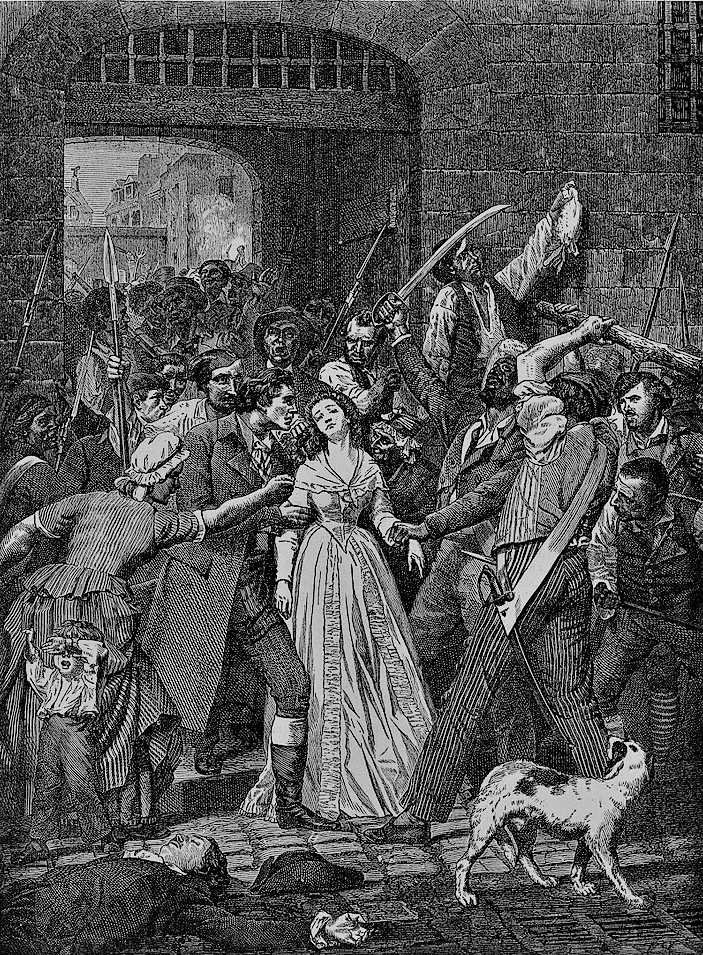
Princess Marie Louise of Savoy is lead through the prison gates and greeted by a marauding mob. Wood engraving.
At 11 AM, a jailer led the two women out of their cell into the nightmarish courtyard. Drunk and belligerent, the men outside taunted and insulted the princess.
The princess bore her lot with dignity, according to Tourzel:
“We clasped each other’s hand … and I can state positively that she displayed much courage and presence of mind, replying without hesitation to all the questions put by the monsters who joined us for the sole purpose of contemplating their victims before leading them to death.”
Tourzel managed to escape the courtyard, due to the help of a mysterious man known as Monsieur Hardi.
The princess, however, was not so lucky. She waited with other doomed political prisoners, to be sent before an impromptu revolutionary tribunal.
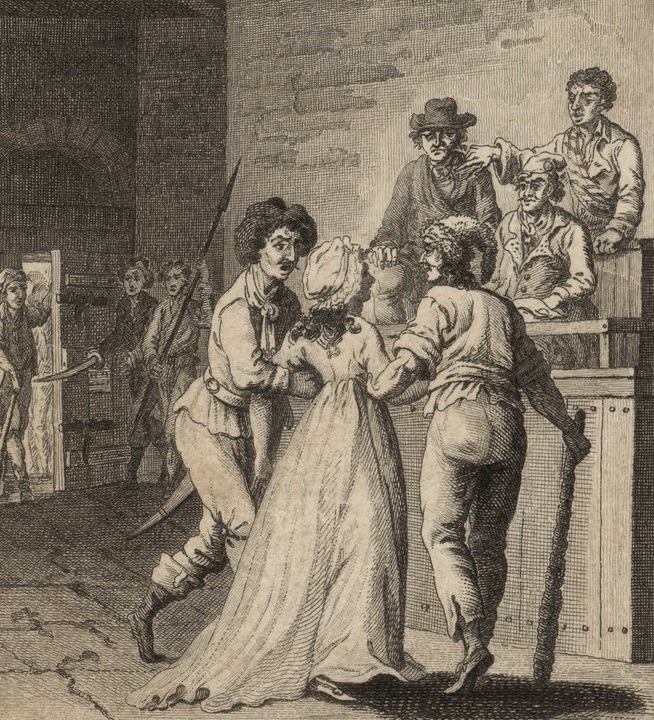
Engraving of the Trial of Lamballe.
The trials, of course, were a farce: they existed only to expedite the killings of political enemies. This was the period of the September Massacres, where thousands would be put to death under the guise of revolution.
And it was the princess’ turn.
Brought before the tribunal in a dank, grim room; the revolutionaries demanded that she “take an oath to love liberty and equality and to swear hatred to the King and the Queen and to the monarchy.” The dialogue went as follows:
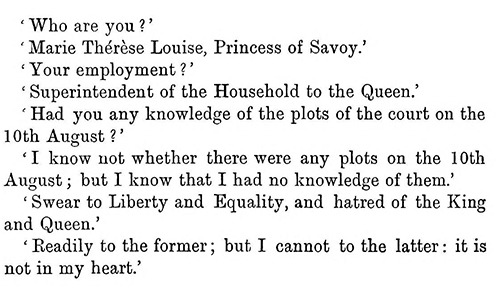
Princess de Lamballe had become fearless in her indignation.
Unlike the other cowardly courtiers who once swarmed Louis XVI’s bustling court- and then fled like rats when trouble hit, the princess actually had values and ideals.
She would not beg for her life like a dog, or shit on the hand that once fed her.
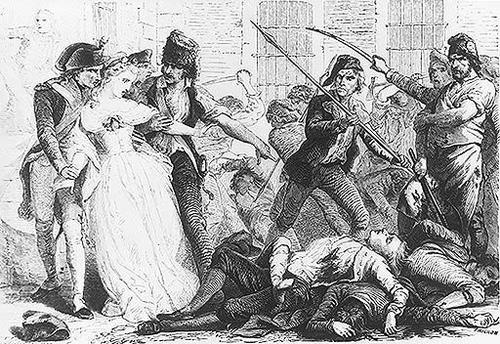
The horrified princesse walks unwittingly into the bloodbath.
The princess simply responded: “‘I have nothing to answer. Whether I die sooner or later is a matter of indifference to me. I have made the sacrifice of my life.”
And with those words, she sealed her fate.
The tribunal called out “Let Madame be set at liberty,” which was actually code for “throw her to the wolves.” Without understanding what was happening, the princess was escorted into the street by two guards.
She was greeted by the scene of a horrific massacre. Piles of naked, bloody corpses were laid out in the open.
An angry mob of men, women, and even children were assigned to slaughtering those who the tribunal deemed as guilty; and they seemed more than happy to do so.
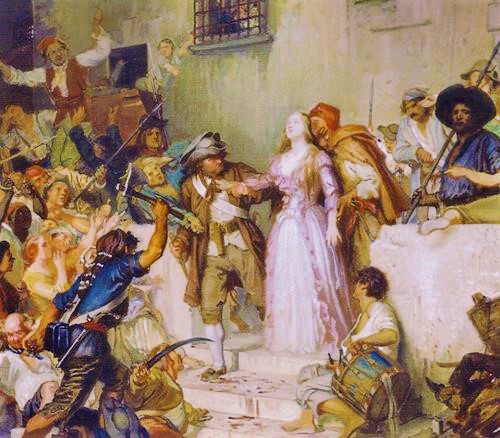
Death of the Princess de Lamballe by Gaetano Ferri, c. 19th century.
The frightened princess fell back on the guards and tried to escape, crying out “Fi horreur!” or “I am lost!” But they clamped her mouth shut to prevent her screams, and pushed her further into the bloodthirsty mob.
A member of the mob described the princess years later as a mere “little lady dressed in white.”
That did not prevent them from murdering her in a terrible manner. A witness described the scene:
“A journeyman barber, staggering with intoxication and infuriated with carnage, endeavored, in a kind of brutal jesting, to strike her cap from her head with his long pike.
The blow fell upon her forehead, cutting a deep gash, and the blood gushed out over her face.”

Etching from 1838 depicting the murder of the princesse de Lamballe during the French Revolution.
The princess’ golden hair came undone, and from her cap fell a letter from her beloved Marie Antoinette.
As blood dripped onto her white silk dress, the mob became emboldened. A man came forth to deliver the final death blow; by bludgeoning her head.
The princess was piled upon and stabbed; then grabbed by the hair and decapitated by a random maniac with a sabre. They went full on slasher movie villain, it seems.
There is also this dramatic firsthand account from a bystander by the name of Jean Némery:
“A quick and horrific scene unfolded before my eyes. On seeing the bodies lying on the ground, the Princess made a gesture of horror and stepped back sharply.
The two men who stood beside her seized her by the arms and spoke to her; she replied, with gestures, but I could not hear her words.
Some of the executioners approached the small group and laughed, probably mocking the fear of the princesse. One of them threatened her with his pike.
She stepped back and raised her arms, as if to protect herself. The executioners had parted and I thought they were going to pass.
I breathed when, suddenly, two of those devils stood before her and beat her, one with a pike, the other with a sword.
She screamed, staggered, put a hand on her chest, then fell onto a pile of bodies … she tried to get up, but she received fresh blows, her arms fluttered a moment, then did not move again.“
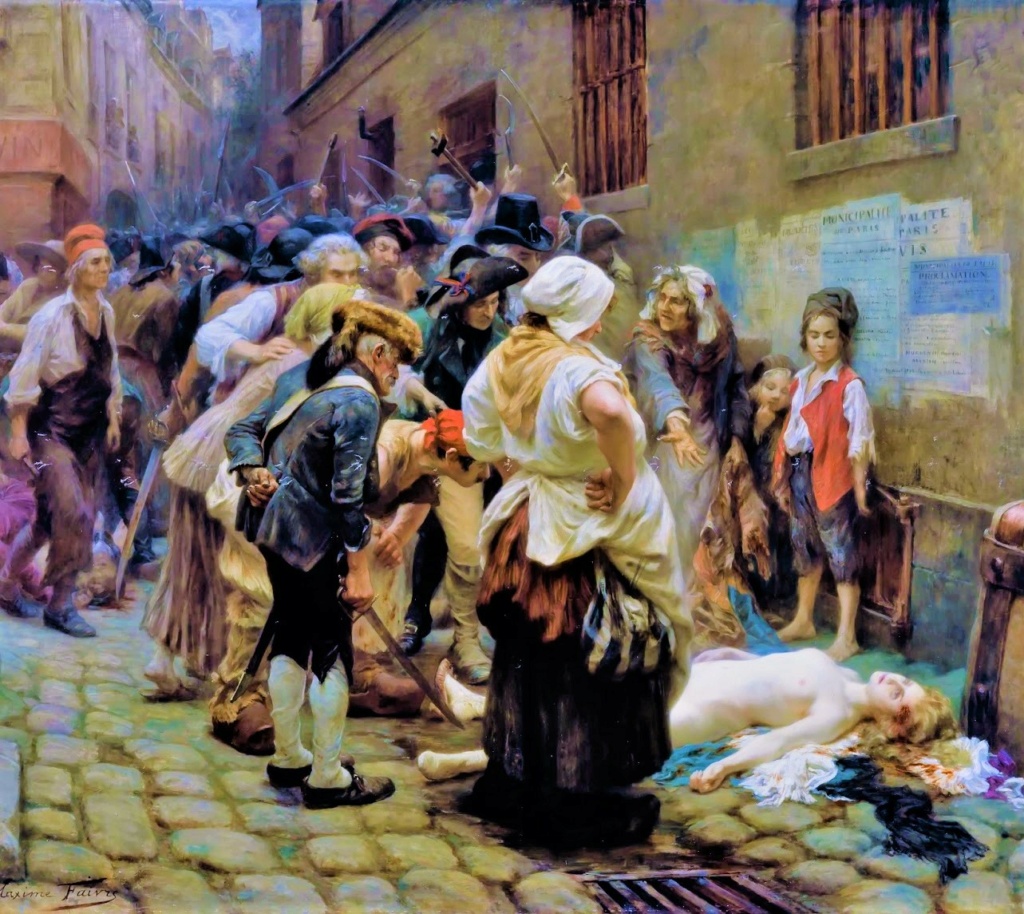
The Death of the Princess de Lamballe by Leon Maxime Faivre, 1908.
Wild rumours later circulated that the princess was raped, dismembered, and sexually mutilated. However, that is all unsubstantiated.
It is fairly likely that they stripped the princess’ corpse naked, and disemboweled her.
What indeed was factual was that the mob placed the princess’ severed head on a pike, and grotesquely paraded it around the streets of Paris.
The deranged procession screamed out the Princess de Lamballe’s name in a macabre trance of celebration and drunken dancing. And to be fair, can you imagine being an 18th century French peasant? This was the highlight of their week.
Execution was an art, a form of entertainment. And here was the Queen’s best friend: whose fortune had been enough to buy whatever she desired, a million times over. She was now headless; a dismembered body in the hands of those who despised what she stood for, of those barely able to even afford bread.
The mob first stopped at a barber shop, and insisted he groom the decapitated head by applying makeup and curling her hair.
The mob then stopped to show the severed head off at a café, where spectators drank to de Lamballe’s death.
Finally, the mob attempted to break into the Temple: the fortress where Marie Antoinette was imprisoned.
If they had succeeded, the mob would have forced her to kiss the decapitated de Lamballe’s lips, as many had assumed she and Marie Antoinette had once been lesbian lovers.
*Insert obligatory joke about giving head here.*
Fortunately, guards managed to prevent the mob from breaking into the Temple, and the King and Queen’s windows were kept closed to prevent them from seeing the princess’ severed head.
When Louis XVI asked why their windows were being shuttered, a guard responded “they are trying to show you the head of Madame de Lamballe.”
A horrified Marie Antoinette nearly fainted away.
Their daughter, Madame Royale, described the scene as such:
“My mother was seized with horror; that was the sole moment when her firmness abandoned her.
The municipals scolded the officer, but my father, with his usual kindness, excused him, saying it was not the officer’s fault, but his own for having questioned him…
My unhappy mother did not even try to sleep [that night]; we listened to her sobs.”
Jean-Baptiste Cléry, valet of Louis XVI, described in his journal the peasants’ attempts to try and show Marie Antoinette her BFF’s decapitated head:
“They had raised the victim’s head so that it could not escape her sight; it was that of the Princesse de Lamballe. Though bloody, it was not disfigured; her blond hair, still curling, floated around the pike.”
It’s nice to know that the princess still looked pretty, even after they cut her head off.
Like a marauding circus, the celebrating mob next went to seek out the Duc d’Orléans and his mistress the Comtesse de Buffon (who as I mentioned before, were not fans of the princess.)
The pair were dining with English gentlemen at the Palais-Royal, when the mob started waving the princess’ severed head by an open window.
The irritated Duke brushed off the bizarre spectacle, commenting “‘Oh, it is Lamballe’s head: I know it by the long hair. Let us sit down to supper.”
The Comtesse, on the other hand, was duly alarmed and cried out “‘O God ! They will carry my head like that some day!”
Luckily for her, that would not happen. However, the cavalier Duc d’Orléans was guillotined the very next year.
The mob couldn’t play with the princess’ detached head forever, could they? They had to be stopped.
Knowing she was in deep trouble, the Duc de Penthièvre had send emissaries to the princess’ trial. They had tried to help her, but they were no match against the thronging mob.
As she was being beaten to death, the emissaries cried out for mercy to try and halt the killing. But the mob disdainfully screamed “Death to the disguised lackeys of the Duc de Penthièvre!’
Now that the princess had been slaughtered, they were charged with obtaining her remains. It was not an easy task. They had to pretend to befriend the mob, so they took the exhausted marauders to an ale house to get them shitfaced.
While the drunks were distracted, an emissary named Jacques Pointel managed to steal the princess’ head off the pike it was impaled on. He wrapped the head in a napkin, and whisked it away; secretly burying it in a children’s cemetery.
Her skull was never found, despite attempts to unearth it in 1904. As for the rest of her body, that is also a mystery.
Poor, old, sickly Duc de Penthièvre was heartbroken when he found out what happened to his much-adored daughter-in-law. She was the light of his life, and he had took her to his bosom like she was his real daughter. He never forgot her, and said:
“I think I always hear her … I always think I see her sitting near the window, in the little study … with what assiduity she used to work there, from morning till night, at the labours of her sex, for the poor? … and this is the angel they have torn to pieces!”
If that doesn’t bring a tear to one’s eye, then what the hell will?
Louis XVI was guillotined in January of 1793. His last words were, “I die innocent of all the crimes laid to my charge. I forgive the authors of my death, and I pray God that the blood which you are about to shed may never fall on France.”
Marie Antoinette was inconsolable after this, and her daughter said she became wholly indifferent to life and death.
She met her end via guillotine in October of the same year. Marie Antoinette accidentally stepped on her executioner’s foot, so her last words came to be, “Pardon me, Sir, I did not do it on purpose.”
Their daughter Marie-Thérèse Charlotte (aka Madame Royale) managed to survive until age 17, after which she escaped France to live in Vienna with relatives from her mother’s side.
Louis-Charles, their son and heir to the throne, was not so lucky. He was imprisoned, abused, and neglected- dying from tuberculosis at the age of 10.
Addendum
Who was this murderous mob of aristo-killers anyways, and why were they so violent?
They were the sans-culottes (without breeches), the lowest of the low; the poorest of the poor.
The sans-culottes were radical militant revolutionaries from the bottom class of French society. There were some career criminals among them, and many seemed to take delight in bloodshed and carnage. Years of destitution had made them monstrous.
There are stories of cannibalism, the murder of priests, and of boiling people alive; all said to have been perpetrated by the sans-culottes. It becomes hard to tell fact from fiction. Marxists brand them as misunderstood heroes, and conservatives as commie devils.
Under Robespierre’s control, these frustrated poor became pawns to carry out acts of violence and mayhem.
Throughout the Reign of Terror, 17,000 French citizens were said to have died. Princess de Lamballe was just one of many victims.
Was it better to be a puppet of the psychopathic Robespierre and his hypocritical bourgeois Jacobins, or a puppet of the decadent and buffoonish King Louis XVI and other selfish monarchs of his ilk?
In the end, the French Revolution achieved everything and nothing. Louis XVI and Marie Antoinette were deposed and executed, but what followed?
A Napoleonic dictatorship and wars that claimed millions of lives, and a Bourbon monarchy that was restored in 1814- only to be overthrown yet again.

Princesse de Lamballe Dancing with Death by Henry Chapront (1876-1965)
France went through several revolutions and republics, the way Marie Antoinette went through pastries.
And yet- would we claim that any of us are truly free men and women? Why celebrate Bastille Day when there is now a Bastille around every corner?
It also begs the question: did the Princess de Lamballe deserve her headless fate?
It depends on how you look at it. To some, she was just a dutiful member of the monarchy; wrongfully caught up in the zeitgeist of her time, inside something that was totally beyond her control.
The princess was not a particularly offensive royal, unlike vulgar thots such as the Duchess de Polignac, or Madame du Barry.
Sorry about that. It's not my opinion of course. 
- By all accounts, the princess was a restrained, dutiful individual- not one for excessive indulgences, starting feuds, or participating in racy love affairs. She was a surprisingly chaste and upright woman.
Not only this, but the princess showed remarkable strength of character and bravery towards the end of her life. She died with dignity, unlike Madame du Barry- who, in comparison, begged for her life like a dog before the executioner guillotined her.
The princess lived a life of wealth and privilege, and, grateful for all that fate had given her; she chose to give her life in return, as payment for the fabulous existence she was briefly granted.
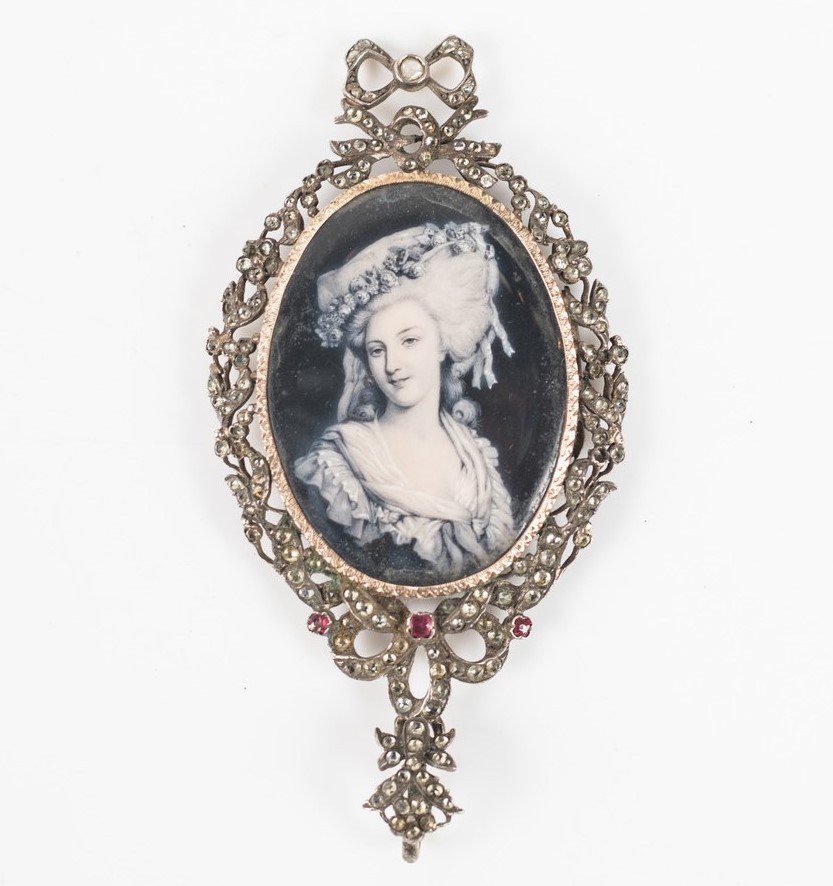
An antique brooch with a portrait of the princesse de Lamballe, circa 19th century.
Her loyalty is inspiring, and even surprising. Not many would die for a friend the way she did.
A contrary argument could also be made: why should we pity a woman who had so much, in a time where others had so little?
She had two extremely wealthy benefactors: Marie Antoinette, the literal Queen of France + her father-in-law, the richest man in France, the Duc de Penthièvre. She refused to reduce her salary or riches, even though she knew those below her were suffering.
The princess received a massive dowry at her wedding: it was said that the amount of jewels that the Duke gifted her could fill up literal pages of text if recorded. When she made out her will, she left a comedic amount of monetary provisions to care for her dogs.
Meanwhile, the diet of the average Frenchman was limited to overpriced bread, and even that was difficult to obtain due to famine and shortages. The princess could arguably be described by her detractors as just another clueless rich bitch.
Marie Antoinette did not actually say the words “Let them eat cake.” However, her ignorant actions were sufficient to prove that she was not fit to govern. But then again, how many political leaders are today? There are many others who deserve the guillotine, yet she was just unlucky enough to actually receive it.
The Royalists (those that were for the monarchy) used the princess’ horrific death as propaganda to discredit the Revolution, and to depict the lower classes of France as senseless barbarians. In death, the princess became a politicized martyr, and many depict her as positively Christ-like
On the other hand, corrupt and degenerate elected officials tell us that the French Revolution was necessary, as the flesh and blood of fallen monarchs paved the way for a more equal, democratic society. Ironically, we now need a revolution in our current time period more than ever.
There is no clear-cut conclusion to be reached in this story, no obvious moral lesson to be preached.
But! If a woman as mild-mannered as Lamballe can be slaughtered in the name of liberty, we can surely guillotine a celebrity or politician or two…right?
To conclude, the internet is full of histrionic individuals worshiping the tragic bromance of Princess de Lamballe and Marie Antoinette. The princess perhaps may be the ultimate Ride or Die. She is the type of girl we all need by our side.

A cute 1900 illustration of Marie Antoinette, the Princesse de Lamballe and the Duchesse de Polignac at the Queen’s hamlet.
Images of the princess’ gory demise have consistently been painted and engraved, for hundreds of years after the fact. The world is obsessed and captivated by this woman’s death, as it came to symbolize everything that was deranged and scary about the French Revolution.
Regardless of everything; the princess and her decapitated head will definitely live on forever in infamy, tragedy and controversy. She embodies the darkest side of glitz and glamour; the highest high, and the lowest, bloodiest end.
Now it's over.  I removed those too horrible cripy pictures of the princess' head on a pike.  The whole story is shared from https://lostgirls.home.blog/2020/04/28/how-marie-antoinettes-bff-lost-her-head/
_________________
Avec elle je ne suis plus la reine, je suis moi
|
|   | | Fleur de Pomme de Terre
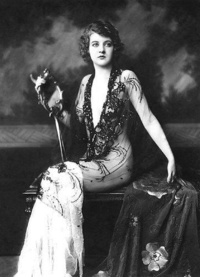
Nombre de messages : 257
Date d'inscription : 01/01/2019
 |  Sujet: Re: How Marie Antoinette's BFF Lost her Head Sujet: Re: How Marie Antoinette's BFF Lost her Head  Dim 27 Déc - 18:31 Dim 27 Déc - 18:31 | |
| Chouette ! Je vais tout lire.  Thank you Little Po. 
_________________
Et c'est quoi maintenant ? Violoncelle ?
|
|   | | bang bang

Nombre de messages : 76
Date d'inscription : 22/03/2023
 |  Sujet: Re: How Marie Antoinette's BFF Lost her Head Sujet: Re: How Marie Antoinette's BFF Lost her Head  Dim 9 Avr - 17:34 Dim 9 Avr - 17:34 | |
| Pauvre Princesse de Lamballe. la fidélité à toute épreuve.
_________________
“C’est légal parce que je le veux.”
|
|   | | Contenu sponsorisé
 |  Sujet: Re: How Marie Antoinette's BFF Lost her Head Sujet: Re: How Marie Antoinette's BFF Lost her Head  | |
| |
|   | | | | How Marie Antoinette's BFF Lost her Head |  |
|
Sujets similaires |  |
|
| | Permission de ce forum: | Vous ne pouvez pas répondre aux sujets dans ce forum
| |
| |
| |
